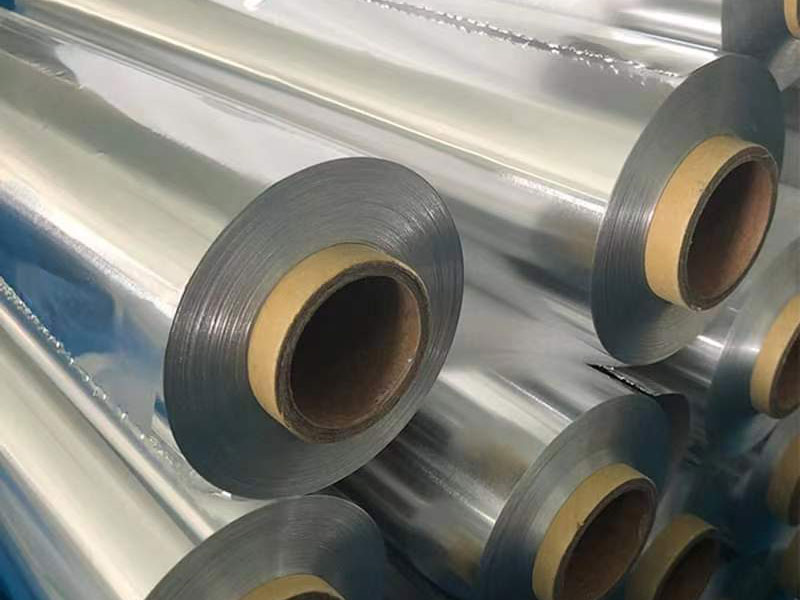
Cold-rolled aluminum foil is a super-thin aluminum product (thickness range: 0.01–0.2mm) produced through processes including melting, casting, hot rolling, cold rolling, and finishing. It is classified by alloy composition:
1XXX Series (e.g., 1060/1100): Pure aluminum with high conductivity and ductility, used in electronics.
3XXX Series (e.g., 3003/3105): Corrosion-resistant, applied in food packaging and pharmaceuticals.
5XXX Series (e.g., 5005/5705): Balanced strength and processability, dominant in construction and home appliances.
6XXX Series (e.g., 6061/6063): High-strength alloy for aerospace and precision instruments.
Melting and Casting
Aluminum ingots with purity ≥99.5% are melted at 750–780°C and cast with controlled cooling rates ≤15°C/min to prevent grain coarsening.
Hot Rolling
Ingots heated to 470–530°C are rolled to thicknesses of 2–5mm to eliminate casting defects and optimize grain structure.
Cold Rolling
Rolling temperature: 0–30°C (low-temperature rolling enhances strength)
Rolling speed: 0.1–3m/s (cooling lubrication required for high speeds)
Thickness tolerance: ±0.005mm (precision foil requirements)
Key Parameters:
Multi-pass rolling (8–20 passes) reduces thickness by up to 90%, achieving ultra-thin foils (down to 0.01mm).
Finishing Process
Bright Finish: Electrolytic polishing (current density 10–20A/dm²) yields surface roughness Ra ≤0.1μm.
Coating Treatment: Fluorocarbon spraying (PVDF film thickness ≥20μm) for enhanced weatherability.
Annealing: Stress relief and plasticity restoration at 300–450°C for 1–5 hours.
Surface Treatment:
Mechanical Performance
Tensile Strength: 100–300MPa (5XXX series up to 270MPa)
Elongation: ≥15% (1XXX series up to 50%)
Hardness: HV 30–80 (dependent on alloy and annealing state)
Surface Quality
Bright foil: Mirror reflectivity ≥85%
Heat-seal foil: Roughness Ra 0.5–3μm (compatible with heat-sealing processes)
Surface State:
Contamination Control: Metal impurities <10ppm, oxygen content ≤0.15%.
Corrosion Resistance
Natural Oxidation: Dense oxide film (10–20nm) with salt spray resistance >96 hours.
Anodized Coating: Corrosion resistance enhanced 5–10x (e.g., black oxide film withstands Cl⁻ ion penetration >5000h).
Packaging Industry
Food Packaging: 3003-series foil (0.03mm thickness) acts as oxygen/light barrier.
Pharmaceutical Packaging: 1060-series sterile foil (FDA-compliant).
Tobacco Packaging: 5005-series foil for fine pattern printing.
Electronic Industry
Capacitor Electrode Foil: 1100-series ultra-thin foil (0.01mm thickness, dielectric constant >100).
Electromagnetic Shielding: 6061-series foil (copper-plated) with shielding效能>40dB.
Construction and Transportation
Insulation Materials: Aluminum foil composites (0.05mm thickness) reflect infrared radiation, improving energy efficiency by 30%.
Automotive Air Conditioning: 5XXX-series foil (thermal conductivity 237W/m·K) for efficient heat dissipation.
New Energy Sector
Lithium-Ion Battery Current Collectors: 6063-series foil with microstructured surfaces to reduce interface resistance.
Fuel Cell Catalyst Supports: Platinum-coated foil (0.1mm thickness).
International Standards
ASTM B221: Specifies foil thickness, mechanical properties, and dimensional tolerances.
ISO 5725: Classifies surface defects (e.g., pinholes, scratches).
Domestic Standards
GB/T 3198: Aluminum foil thickness tolerance (±3%).
GB/T 1629: Anodized film thickness measurement (ellipsometry method).
Ultra-Thinning: Development of nanoscale foil (<0.005mm) for flexible electronic devices.
Functionalization:
Conductive Coatings: Graphene composite foil (conductivity >10⁶ S/cm).
Self-Healing Coatings: Microcapsule technology for scratch repair.
Green Manufacturing:
Recycled Aluminum Foil: Recovery rate >95%, carbon emissions reduced by 40%.
Acid-Free Rolling: Environmentally friendly lubricants replacing mineral oils.
Cold-rolled aluminum foil remains an indispensable material in high-end manufacturing due to its superior properties, driving innovation in packaging, electronics, and renewable energy sectors through continuous technological advancements.